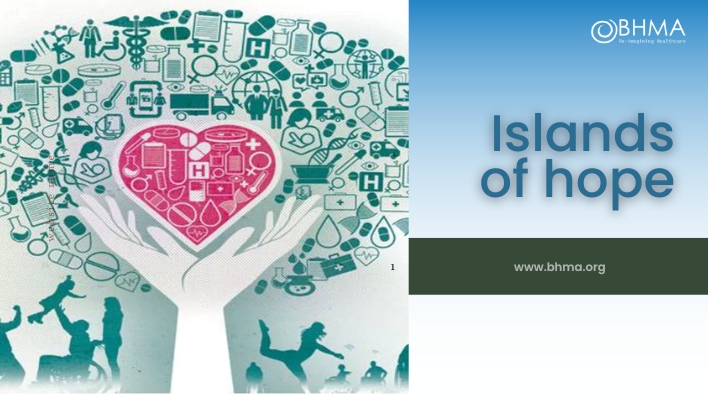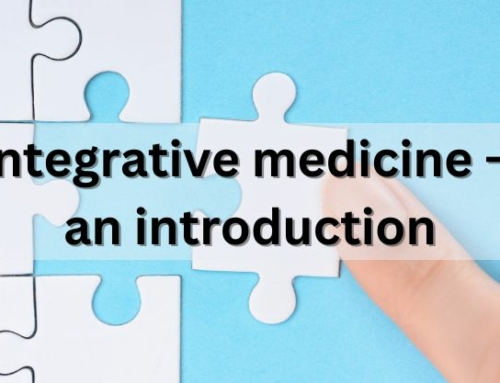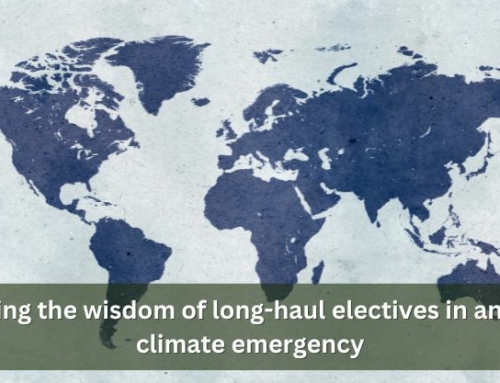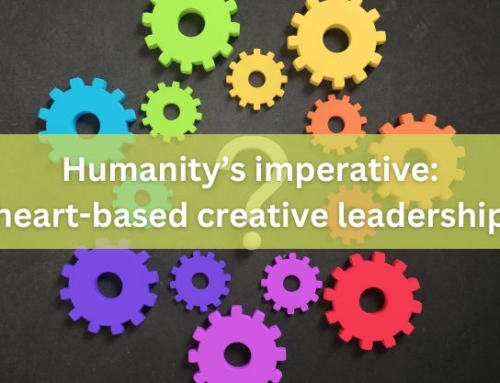Islands of hope
William House, Chair, BHMA
Published in JHH13.3 – Saving the NHS
Providing a compassionate and caring service to the sick is hard.When faced with the difficulties and frustrations of working of the English National Health Service this hard job can become impossible. It is easy to become demoralised and negative, even burned out. So we all need hope.This article is about new and novel ways of caring for the sick while helping to keep people well in a holistic way. My own work as a GP for 30 years in the south west of England inspired me to look for better ways and to try them out. I and others are developing an experimental scheme amongst the people who were my patients and colleagues.Along the way I have been inspired by all three of the schemes described in this article. I hope you will be too.
Be compassionate, be a friend, have fun, assume it’s possible.’ Click To Tweet In his farewell address in 1961 President Dwight D. Eisenhower offered the nation a warning about what he called ‘the military-industrial complex’ (MIC). This is an ‘informal alliance between a nation’s military and the defense industry which supplies it, seen together as a vested interest which influences public policy’. It was not long (1969) before this form of alliance was recognised in healthcare: the ‘medical industrial complex’ (MIC). Similar warnings accompanied both movements: that military and healthcare policies would meet the needs of the respective supply industries at the expense of their prime purposes: to keep the nation safe and healthy respectively.
A crisis of scarcity
Medical science has made such tremendous progress that there is hardly a health human left.
Aldous Huxley
The source of the energy driving both MICs is, of course, money. In a system driven by money it pays for a lot of people to desire something which seems to be scarce. We then barely notice things that are plentiful. The frustration, stress and fear of disappointment in your desire is bad for your health. If the desired object is healthcare, you then have (at least from the monetary viewpoint) a virtuous circle for the supplier and a vicious circle for the people. Everyone in the system becomes stressed. Some also make a lot of money. The recent junior doctors’ industrial action in the UK was an unprecedented expression of the stress and frustration of working in this system: insufficient nurses, and doctors avoiding specialities with frontline pressure, especially general practice and A&E. In response to this scarcity, we all demand more, and so it goes on. It is soul-destroying.
Though we humans may get carried away by the wonder of our inventions, we can also step back and constructively re-examine our purposes. Of course, the British Holistic Medical Association (BHMA) emerged in 1983 with exactly this sort of informal reflective inquiry. More recently, there are others. In the early noughties, the preventing over[1]diagnosis (POD) movement began its questioning of the medicalisation of human suffering. About the same time (2001) the Scotland-based International Futures Forum (IFF) began its journey towards addressing ‘complex, messy, seemingly intractable issues’. Emerging from the restive atmosphere, coupled with reflective movements, experi[1]ments have appeared. Here I take three particularly inter[1]esting ones and tease out some common features. Their interest lies in their integration with the communities they serve.
Three islands of change
You never change things by fighting the existing reality. To change something build a new model that makes the existing model obsolete.
Buckmaster Fuller
Bromley by Bow Centre, East London, UK
This now famous community centre began in 1984 with the arrival Andrew Mawson as minister of a small Church. It had only a handful of members and was heading for closure. Bromley by Bow was a deprived area even by East London standards. It is one of the world’s most racially diverse places with a majority professing the Muslim faith. Andrew and his wife, Susan, made a bold decision to gather a group of local older people and open the church for local projects. ‘The key driver was the assumption that people were the future and that you couldn’t sit around and wait for the State to provide the much-needed services in a poor community. This dynamic approach led to a number of new initiatives which were very much about backing people, their ideas and their passion.’ Their mission became one ‘to help create a cohesive, healthy, successful and vibrant community, and to remove the label ‘deprived’ from Bromley by Bow.’ Early in the development the growing team decided to build a new GP surgery adjoining the church. Having built it, they then advertised for general practitioners to join the team and grow a practice in line with the ethos of the Centre. This proactive and entrepreneurial community spirit has fueled remarkable growth.
The centre today is about enabling the people to reach their full potential. ‘The end result is achieving changes in their lives and circumstances that they never dreamed were possible when they first arrived.’ The centre’s ‘active values’ are:
Their ‘ten top tips’ (really a set of priorities) starts with:
The quality of the human relationships’
All of these are made possible by conversations. Without conversations, none of them can happen. These are encouraged in many ways at the centre, for instance, having no signage so that you have to ask someone – have a conversation. Though much depends on the quality of the conversations, even asking the way can be the beginning.
The team now describes the centre as a ‘community department store’ making use of the footfall, not to make money, but to build the vibrancy that we know creates health. So it is the active values and not the money that drives the organisation. It is now an independent charity with around 150 staff on 25 sites and many spin-off businesses. Whether growing to such scale is a good thing is a separate question.
NUKA – Southcentral Foundation,Alaska, USA
This story started in 1979 with the appointment of Dr Kevin Gottlieb as the first dentist in a new dental clinic opened by the Cook Inlet Native Association. Having worked in the local hospital (operated from the US federal government 5,000 miles away) and witnessed the very poor care delivered to native peoples, he understood the value of local native management. When the recently formed nonprofit organisation (social enterprise) Southcentral took over the clinic and a few other primary healthcare services in 1985, the fundamental values of NUKA were clear in Gottlieb’s mind: a welcoming environment, personal relationships, ease of access and continuity of care. ‘NUKA’ is an Alaskan Native name given to ‘strong, giant structures and living things’. So the healthcare system becomes a ‘living thing’. Initially, Southcentral ran only services tailored specifically to the priority needs in the community, in particular mental health and substance abuse, offering treatment and prevention using behavioural programmes long before they began elsewhere. Finally, in 1992 the US federal government agreed to devolve to Southcentral the budget for all primary, community and mental health services, with freedom to innovate as necessary. They grabbed this chance with both hands and redesigned the entire system in line with the NUKA concept and traditional values (Hannah 2013). The first two years were spent listening to the community, basing the system design on what they heard.
Over 20 years it has transformed local healthcare from a very poor, costly and unpopular service to one where families and communities have taken ownership of their own wellness and recovery, with reduced costs and some of the best health results in the world. (Betz 2015) They have planned and developed the transformation in thoughtful and ingenious ways which honour the indigenous values. For instance, they empower the users of the system in many ways, such as calling patients ‘customer-owners’; designing workspaces that are non[1]hierarchical; calling clinical rooms ‘talking rooms’ (reflecting the importance of conversations); and providing uniform size and design of chairs. Regarding their vision, mission, goals and concepts, these are woven through all systems and processes. For instance, by presenting them as acrostics, such as the ‘operating principles’ spelling out:
R – E – L – A – T – I – O – N – S – H – I – P – S
The first two letters represent ‘Relationships between the customer-owner, the family, and provider must be fostered and supported’; and ‘Emphasis on wellness of the whole person, family and community including physical, mental, emotional, spiritual wellness’. In line with this, all their resources are focused on the generalist model, bringing in specialists only when essential. In 2003 they introduced a ‘Data-Mall’ – a sophisticated data-gathering and display system. This has nothing to do with targets or financial incentives (there are none of these), but is rather a form of action learning – from each other. Regarding continuity of primary care, each GP works within a small team providing the key skills needed for the population and every registered customer-owner is encouraged to stay with one team.
The Foundation now provides services for about 55,000 Alaskan Native and American Indian people in the Anchorage area of Alaska, and about 10,000 people in 55 remote villages accessible only by plane
Fife SHINE Project – Scotland
This project is much younger than the other two and emerged in part from the NUKA transformation. Fife SHINE started with a conversation in 2009 about winter planning for NHS Fife. The particular concern was delayed discharge of older people because of inadequate support at home – a common problem throughout the UK. Through further conversations with the International Futures Forum (IFF) it was clear that the solution required a radical shift in culture (Leicester 2016, pp 22, 39). Parallels were seen between this problem and aspects of the NUKA project and exchange visits were organised with members of NUKA. This led to a specific focus on conversations and how these could enable people to thrive at home despite difficult circumstances. Similarities then emerged with Asset Based Community Development and with social prescribing with the possibility of a shift in community culture towards more self-reliance and caring for others. The Fife SHINE project got underway in 2011 with a grant from The Health Foundation. It involved training for NHS and social care staff in having ‘good’ (enabling and empowering) conversations with older people so they can identify what changes would help them to thrive. This is not a healthcare conversation about ‘what is the matter with you?’, but rather a conversation about ‘what matters to you?’ This is combined with largely voluntary community support in helping vulnerable people to make the changes the vulnerable person identifies. Ultimately, they may be able to support others to thrive in their turn. By early 2016 at least 15,000 people had experienced a ‘good’ conversation, with numbers increasing steeply.
In her inspiring book, Humanising Healthcare – Patterns of Hope for a System under Strain (Hannah 2014), Margaret Hannah – one of the small group behind Fife SHINE – writes about her frustrations and the vision and values that drive that project. You can also watch her speak at the book launch (https://vimeo.com/119180069).
It is too early to judge the transformative potential of this project, but it is included to show firstly, how one set of conversations leads to another which may lead to radical change. Both Bromley by Bow and NUKA will have passed through this phase of uncertainty. The other message from this is that projects in very different places with very different populations and challenges can be inspirations for one another. Using ideas is not a matter of copying, it’s rather translating into the ‘language’ of a different place. There is no best practice, any more than there is a best marriage!
Conclusions
Never doubt that a small group of concerned citizens can change the world. Indeed, it is the only thing that ever has.
Margaret Mead
It is clear to me that the energy driving the work and direction in all three of these examples comes from the people using and providing the services. Money takes a secondary role. I included the story of the genesis of each project to emphasise this and as a reminder of the ordinariness of the circumstances at the beginning. In many ways, the individuals driving the change were ordinary too. They saw that their situation was not good and had the courage to do something about it. But as we can see clearly in the Fife SHINE it takes conversations to change things. It cannot be done by one person acting alone. The intriguing thing about this example is that the conversation is both the proposed solution and the means of achieving it. The nature of the conversation matters. It needs to be a ‘dialogue’. This entails listening in an open way – suspending judgment. IFF call a group of people having this sort of conversation a ‘creative integrity’ (Leicester 2016, chapter 4).
There is a certain ordinariness in the values that underpin and drive each example. If there is anything extraordinary, it was their insistence on keeping those values at the forefront of what they are doing, but the people with the values are ordinary people. This is surely an empowering thought about abundance. In the UK we live in a world of celebrity. This is disempowering! We invest in others our own hopes and fears and thereby lose control of them and feel vulnerable. In fact, making changes involves moving from control to participation. We can all do this. We can feel vulnerable together and that is the source of strength. The energy and capacity for chang[1]ing the world exists in every one of us. It is called love.
References
- Betz A (2015) The future of our NHS and the power of community JHH 12(2) pp21).
- Hannah M (2014) Humanising healthcare – patterns of hope for a system under strain. Axminster: Triarchy Press.
- Hannah M (2013) Compassion in public health. JHH 10 (3) pp23.
- Leicester G (2016) Transformative innovation. Axminster: Triarchy Press, pp 22,39).







